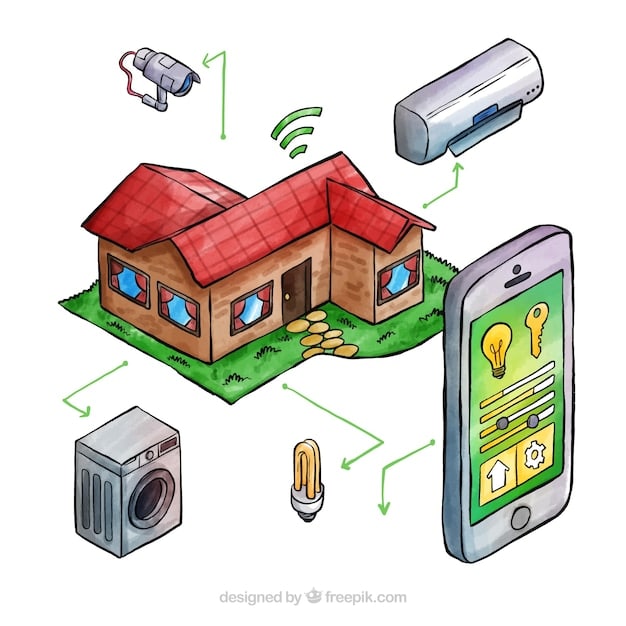LIHEAP 2025: Apply & Save on Energy Bills

The Low Income Home Energy Assistance Program (LIHEAP) offers crucial financial aid for eligible low-income households in the US, helping them manage heating and cooling costs, prevent utility shut-offs, and undertake minor energy-related home repairs, significantly reducing energy burdens and ensuring home comfort and safety.
Navigating the complex landscape of government assistance programs can be challenging, especially when household budgets are stretched thin. For many low-income families across the United States, keeping homes warm in winter and cool in summer can be a significant financial burden. This is where the Low Income Home Energy Assistance Program (LIHEAP): How to Apply and Save on Energy Bills in 2025 becomes an essential lifeline, offering critical support to ensure comfort and safety without compromising financial stability.
Understanding the LIHEAP Program
The Low Income Home Energy Assistance Program (LIHEAP) is a federally funded program designed to assist low-income households with their energy costs. It is administered by the U.S. Department of Health and Human Services (HHS) through the Office of Community Services (OCS). While the funding comes from federal sources, the program is implemented at the state and tribal levels, meaning that specific eligibility requirements and benefits can vary significantly depending on where you live.
LIHEAP aims to reduce the energy burden on vulnerable households. This burden is often disproportionately felt by the elderly, individuals with disabilities, and families with young children, who may spend a larger percentage of their income on home energy, particularly during extreme weather conditions. The program helps offset utility costs, preventing shut-offs, and in some cases, providing for minor energy-related home repairs.
Who is LIHEAP for?
The program targets households earning low incomes. Generally, eligibility is tied to federal poverty guidelines or a percentage thereof. Most states set their income limits at 150% or 175% of the federal poverty level, though some may go up to 60% of the state median income. Specific criteria often include:
- Income level: Households must meet state-specific income thresholds.
- Household size: The number of people in the household affects the income limits.
- Energy burden: Some states prioritize households with a higher energy burden relative to their income.
What Type of Assistance Does LIHEAP Provide?
LIHEAP typically offers several types of assistance to eligible households. These can include direct payments to utility companies, crisis assistance, weatherization, and minor energy-related home repairs. The goal is to provide a comprehensive approach to energy affordability, not just a temporary fix.
The core objective of LIHEAP is to safeguard residential heating and cooling, preventing the health and safety risks associated with extreme temperatures. It serves as a vital safety net, protecting millions of Americans from the severe consequences of energy poverty. Understanding these fundamental aspects is the first step in determining if LIHEAP is the right solution for your household’s energy needs. The program’s flexibility allows states and tribes to tailor their implementation to best serve their unique populations.
In essence, LIHEAP is more than just a financial handout; it’s an investment in the health, safety, and stability of low-income communities. By alleviating energy costs, the program enables households to allocate funds to other essential needs like food, medicine, and housing, contributing to overall well-being. This multifaceted support system underscores its critical role in the broader social safety net of the United States. Furthermore, LIHEAP’s adaptive nature ensures that it can respond to evolving energy challenges and economic shifts, providing consistent support year after year.
Eligibility Requirements for LIHEAP in 2025
To successfully apply for the Low Income Home Energy Assistance Program (LIHEAP) in 2025, understanding the eligibility requirements is paramount. While LIHEAP is a federally funded program, the specifics often vary by state and even by local administering agencies. This means what applies in one state may be slightly different in another, necessitating a localized approach to information gathering.
The primary determinant for LIHEAP eligibility is household income. Most states set their income threshold between 150% and 175% of the Federal Poverty Guidelines (FPG). However, some states might use 60% of the state median income as their benchmark, which can be higher in areas with a higher cost of living. It is crucial to verify the exact income limits for your specific state or tribal area for the 2025 program year, as these figures are updated annually. For example, a family of four earning $40,000 might qualify in one state but not in another if the FPG percentages differ.
Income and Household Size
Your household’s gross monthly income, before taxes and deductions, is typically the figure used for calculation. All members of the household aged 18 and over who contribute to the household income usually have their earnings counted. The size of your household directly influences the income threshold; larger households typically have higher allowable income limits.
- Identify all household members: Ensure everyone living in the home is included.
- Gather income documentation: This includes pay stubs, Social Security benefit letters, unemployment benefits, and any other sources of income.
- Calculate total gross monthly income: Sum up all income sources for all household members.
Beyond income, other factors can influence eligibility. These often include the presence of vulnerable individuals within the household, such as young children (typically under 6), elderly individuals (usually 60 or 65 and older), or individuals with disabilities. Households with high energy burdens—meaning they spend a disproportionately large percentage of their income on heating or cooling—may also receive priority.
Other Potential Eligibility Factors
While income is the main gateway, several other factors can affect your eligibility or the priority you receive. These typically include:
- Residency status: You must be a legal resident of the state or tribal area where you are applying.
- Crisis situations: Households facing immediate energy crises, such as a utility shut-off notice or a empty fuel tank, are often prioritized for immediate assistance.
- Energy burden: Some programs consider the applicant’s prior energy consumption and costs relative to their income.

Each state’s LIHEAP program is tailored to address the specific needs and energy landscape of its population. Therefore, what constitutes “low income” or an “energy crisis” can have slight variations. It is always recommended to consult the official website of your state’s LIHEAP agency or contact them directly. Many states provide online eligibility screening tools that can give you a preliminary indication of whether you might qualify. Staying informed about these specific requirements for 2025 can streamline your application process significantly and increase your chances of receiving the much-needed energy assistance.
Understanding these intricacies ensures applicants present a complete and accurate picture of their financial situation, which is crucial for a successful application. Being proactive in gathering all necessary documentation before applying will also help avoid delays, ensuring that assistance can be provided in a timely manner, especially during peak heating or cooling seasons.
The Application Process for LIHEAP in 2025
Applying for the Low Income Home Energy Assistance Program (LIHEAP) requires a systematic approach to ensure all necessary documentation is in order and deadlines are met. While the general framework is federal, the exact application process can differ from state to state and even within different counties or tribal areas. Nonetheless, there are common steps and essential documents that nearly every applicant will need to prepare.
The first step in applying is to identify your local LIHEAP administering agency. This is usually a state or county social services department, a community action agency, or a tribal organization. Many states provide a dedicated LIHEAP portal on their official government websites where you can find contact information, application forms, and specific instructions for your area. These agencies are responsible for processing applications, determining eligibility, and distributing funds.
Gathering Required Documentation
Once you’ve identified your local agency, the next crucial step is to gather all the necessary documents. Missing or incomplete documentation is one of the most common reasons for delays or denials. Essential documents typically include:
- Proof of Income: This includes pay stubs for the last 30 days, Social Security award letters, Disability benefits, unemployment benefits, pension statements, or any other source of income for all household members.
- Proof of Identity: A government-issued photo ID for the primary applicant (e.g., driver’s license, state ID card).
- Proof of Residency: A utility bill, lease agreement, or other official document showing your current address.
- Utility Bills: Copies of your most recent heating and/or cooling bills. Even if your utilities are included in your rent, you might still be eligible, but you’ll need documentation from your landlord.
- Social Security Numbers: For all household members.
It’s always advisable to have copies of these documents ready. Some agencies might allow you to submit applications online, while others may require in-person submission or mail. Regardless of the method, make sure to keep records of your application and any correspondence.
Submission and Follow-Up
After compiling all your documents, you can submit your application. Be aware of application periods, as LIHEAP funds are limited and allocated annually. Many states open their application window in the fall for heating assistance and in the spring/summer for cooling assistance. Applying early can be beneficial to ensure you receive aid before funds are exhausted.
Once your application is submitted, it will undergo review. This process can take several weeks, especially during peak application periods. If your application is incomplete or if the agency requires additional information, they will contact you. Responding promptly to these requests is vital. If your application is approved, the assistance funds are typically paid directly to your utility company or fuel vendor. In some cases, a direct payment may be issued to the household, particularly for specific crisis interventions.
Staying diligent throughout the application process, from gathering documents to following up on your submission, significantly increases your chances of receiving timely assistance. Each state’s LIHEAP website is your best resource for precise guidance for 2025, ensuring you meet all local requirements and deadlines.
Maximizing Your Energy Savings with LIHEAP and Beyond
While the Low Income Home Energy Assistance Program (LIHEAP) provides crucial financial relief for energy bills, it’s equally important to adopt strategies that reduce energy consumption in the first place. Pairing LIHEAP assistance with smart energy-saving practices can significantly enhance your household’s financial stability and comfort over the long term. This integrated approach ensures that the aid received from LIHEAP goes further, providing more sustainable benefits.
One of the most effective ways to maximize energy savings is through basic home weatherization. Many LIHEAP programs actually offer a component for minor energy-related home repairs or referrals to state-funded weatherization programs. Even without direct program assistance, small, inexpensive changes can make a big difference.
Simple Energy-Saving Tips for Your Home:
- Seal Air Leaks: Use caulk or weatherstripping around windows and doors to prevent conditioned air from escaping and unconditioned air from entering. This can be one of the simplest yet most impactful improvements.
- Adjust Thermostat Settings: In winter, set your thermostat to the lowest comfortable temperature (e.g., 68°F during the day and lower at night or when away). In summer, set it higher (e.g., 78°F). Every degree can make a noticeable difference in your energy bill.
- Maintain HVAC Systems: Regularly replacing air filters (monthly or every three months) ensures your heating and cooling systems run efficiently. Consider professional tune-ups if affordable, as well-maintained systems use less energy.
- Unplug “Energy Vampires”: Electronic devices like TVs, chargers, and gaming consoles consume power even when turned off if they’re still plugged in. Unplug them or use power strips that can be switched off.
Beyond these immediate actions, consider your energy habits and how they contribute to your overall consumption. Simple behavioral changes can yield substantial savings. For instance, using natural light during the day, washing clothes in cold water, and air-drying laundry when possible can all contribute to lower utility bills.
Leveraging Related Programs and Resources:

Explore other government or local utility company programs that complement LIHEAP. Many utility providers offer energy audits (some free of charge) that identify specific areas for energy waste in your home and recommend improvements. They might also have their own assistance programs or discounted rates for low-income customers.
Additionally, state and local governments often have weatherization assistance programs (WAP) that provide comprehensive energy efficiency upgrades for eligible low-income homes, often at no cost. These programs can include improvements like insulation, heating system repairs, and replacement of inefficient appliances, leading to significant, long-term reductions in energy consumption and bills. Combining direct financial assistance from LIHEAP with these weatherization efforts creates a powerful synergy, ensuring both immediate relief and sustained energy savings.
By actively implementing these energy-saving strategies in conjunction with LIHEAP benefits, households can achieve greater control over their energy consumption and expenditures, fostering a more secure and comfortable living environment long after the direct assistance is applied.
Crisis Assistance and Preventing Utility Shut-Offs
The Low Income Home Energy Assistance Program (LIHEAP) offers a critical component known as crisis assistance, specifically designed to help low-income households facing immediate energy emergencies. This aspect of the program is vital for preventing utility shut-offs, restoring services, or mitigating dangerous heating or cooling situations, particularly during extreme weather conditions. Understanding how this assistance works and how to access it can be a lifesaver when you’re in urgent need.
Crisis assistance is typically available to households that have received a shut-off notice from their utility provider, whose energy service has already been disconnected, or those facing a life-threatening situation due to lack of heating or cooling (e.g., a furnace breakdown in winter or broken air conditioning during a heatwave, especially for vulnerable individuals). Eligibility for crisis aid is usually more immediate and requires quicker processing compared to regular energy assistance, recognizing the urgency of the situation.
How Crisis Assistance Works:
- Immediate Threat: The household must demonstrate an immediate energy crisis, such as a utility disconnection notice, a shortage of deliverable fuel (like oil or propane), or an inoperable heating/cooling system.
- Application Process: While similar to the regular LIHEAP application, crisis assistance often has an expedited review process. Applicants may need to provide the shut-off notice or a repair quote for their heating/cooling system.
- Direct Payment: Funds are typically paid directly to the utility company or fuel vendor to reinstate service or deliver fuel. For system repairs, payments may go to the service provider.
It’s crucial to act swiftly if you receive a shut-off notice. Do not wait until the last minute. Contact your utility company immediately upon receiving notice to explore payment arrangements or brief extensions. Then, promptly reach out to your local LIHEAP agency to inquire about crisis assistance eligibility and the application process. Many agencies have dedicated helplines or staff for emergency situations.
Preventing Future Crises:
While crisis assistance provides immediate relief, the long-term goal is to help households maintain stable energy services. This involves not only utilizing LIHEAP funds but also adopting strategies to prevent future emergencies. Establishing a budget that accounts for energy costs, even if estimated, can help. Exploring average monthly billing plans with your utility company can also stabilize your payments, avoiding large spikes during peak usage months.
Another layer of protection is understanding your rights as a consumer regarding utility shut-offs. Many states have regulations that protect vulnerable populations from immediate disconnections, especially during extreme temperatures or if there are medical emergencies in the household. Familiarizing yourself with these protections can provide a crucial buffer. The ultimate aim is to use LIHEAP crisis assistance as a bridge, giving you the immediate support needed to stabilize your energy situation and implement preventative measures for long-term energy security.
By understanding the mechanisms of crisis assistance within LIHEAP and combining it with proactive measures, low-income households can significantly reduce their vulnerability to energy emergencies, ensuring continuous access to safe and essential home energy services.
LIHEAP Funding and State-Specific Variations in 2025
The effectiveness and accessibility of the Low Income Home Energy Assistance Program (LIHEAP) are heavily influenced by its funding levels and the significant variations in how the program is administered at the state and tribal levels. While LIHEAP is a federally funded program, the amount of money designated for it can fluctuate year to year based on congressional appropriations. This funding, once allocated, is then distributed to states and territories, which possess considerable discretion in how they design and implement their specific LIHEAP programs for their residents.
This decentralized approach means that applicants should not expect a uniform experience across the United States. What one state offers in terms of benefit amounts, eligibility thresholds, or application periods might be vastly different from another. For example, a state with a colder climate might allocate more funds towards heating assistance, while a state with hot summers might prioritize cooling assistance.
How Funding Impacts Services:
- Benefit Amounts: Higher federal appropriations can translate to larger individual household benefits or the ability to serve more households. Conversely, reduced funding may lead to smaller average payments or longer waiting lists.
- Types of Assistance: The availability of specific assistance types—such as weatherization or minor energy repairs—can depend on state priorities and funding levels. Some states might focus exclusively on heating and cooling utility payments.
- Application Periods: Funding levels can influence how long application periods remain open. States with limited funds may close their programs once their allocation is exhausted, sometimes earlier than anticipated.
States also have flexibility in setting their income eligibility limits, provided they stay within the federal guidelines (typically between 150% and 175% of the Federal Poverty Guidelines, or up to 60% of the state median income). This means a household that qualifies in a lower-income state might not meet the criteria in a state with higher median incomes, even if both states are within federal parameters. Additionally, states can impose their own rules regarding asset limits, the frequency of assistance, and the method of payment (e.g., direct to vendor vs. direct to household).
Navigating State-Specific Programs:
Given these variations, the most critical step for any potential applicant in 2025 is to consult their specific state’s LIHEAP official website or contact their local LIHEAP agency. These resources will provide the most accurate and up-to-date information regarding:
- Precise income thresholds for your household size.
- Available types of assistance (e.g., heating, cooling, crisis, weatherization).
- Application opening and closing dates.
- Required documentation specific to that state.
- Contact information for local administering agencies.
Understanding these state-specific nuances is paramount to a successful application. Relying on general information can lead to frustration and delays. Many state LIHEAP websites also offer FAQs, downloadable forms, and even online portals for application submission. Staying informed at the local level ensures that you are prepared for the particular requirements of your state’s LIHEAP program, allowing you to access the necessary energy assistance efficiently and effectively.
The program’s design, while allowing for state-level responsiveness, necessitates that individuals seeking aid perform diligent research specific to their locale. This commitment to discovering localized information directly impacts the success of one’s application and the potential for a more stable energy future.
Beyond LIHEAP: Other Energy Assistance Resources
While the Low Income Home Energy Assistance Program (LIHEAP) is a cornerstone of federal aid for energy costs, it is not the only resource available to households struggling with utility bills. Many states, local communities, and even utility companies offer additional programs that can provide further relief or complementary support. Understanding these “beyond LIHEAP” options is crucial for a comprehensive approach to managing energy expenses, particularly for low-income households in 2025.
Exploring other avenues for assistance can often fill gaps that LIHEAP might not cover, or extend support to households that may not fully qualify for LIHEAP due to specific income thresholds or program limitations. These programs vary widely by geographic location and often target specific demographics or types of energy needs.
State and Local Programs:
Many states operate their own energy assistance programs, sometimes independent of or in conjunction with federal LIHEAP funds. These can include state-funded heating or cooling assistance, emergency utility relief funds, or voucher programs. Local counties and cities sometimes have community action agencies or social service departments that administer smaller, localized grants or partnerships with non-profits to support residents in need. A good starting point is to contact your state’s social services department or search for “energy assistance [Your State/County Name]” online.
- Weatherization Assistance Program (WAP): This federal program, administered by the Department of Energy, provides free weatherization services to low-income households. Services can include insulation, air sealing, and heating system repairs, significantly reducing overall energy consumption and costs. WAP often works hand-in-hand with LIHEAP, providing long-term structural solutions while LIHEAP offers immediate bill payment assistance.
- Emergency Rental Assistance Programs (ERAP): While primarily focused on rent, some ERAP funds may be used for utility arrears if they are part of a broader housing instability issue, preventing eviction or homelessness.
Utility Company Programs:
Most major utility companies offer their own assistance programs for low-income customers. These can include:
- Arrearage Management Programs (AMPs): These programs help customers with accumulating debt on their utility bills by forgiving portions of the debt as they make consistent, on-time payments.
- Budget Billing or Average Payment Plans: These plans average your annual energy costs into consistent monthly payments, preventing seasonal spikes and making budgeting easier.
- Discounted Rates: Some utilities offer reduced rates or special tariffs for qualifying low-income residential customers.
- Energy Audit and Efficiency Programs: Many utilities provide free or low-cost home energy audits and rebates for installing energy-efficient appliances or making home improvements.
To find out about these utility-specific programs, simply visit your utility provider’s website or call their customer service line and ask about assistance options for low-income households. They often have dedicated departments or resources to guide you through available programs.
By leveraging a combination of LIHEAP, state/local programs, and utility-specific offerings, households can create a robust safety net against high energy costs. This comprehensive approach is essential for achieving true energy security and financial stability, ensuring that families can maintain comfortable and safe living conditions without undue economic burden in 2025 and beyond.
| Key Aspect | Brief Description |
|---|---|
| 💰 Eligibility Factors | Primarily based on household income (150-175% FPG) and household size; varies by state. |
| 📝 Application Process | Identify local agency, gather income/ID/bill docs, submit during open periods. |
| 💡 Energy Savings | Combine LIHEAP with weatherization, thermostat adjustments, and behavior changes. |
| 🚨 Crisis Aid | Expedited help for shut-off notices or immediate energy emergencies. |
Frequently Asked Questions About LIHEAP
▼
LIHEAP, or the Low Income Home Energy Assistance Program, is a federally funded program aiding low-income households with energy costs. It focuses on helping families, the elderly, and individuals with disabilities manage heating and cooling expenses, preventing utility shut-offs, and addressing energy-related crises to ensure comfortable and safe living conditions.
▼
The frequency of LIHEAP assistance depends on your state’s program guidelines. Generally, households can apply once per program year for regular heating or cooling assistance. However, separate funding or application periods may exist for crisis assistance if you face an immediate energy emergency, allowing for additional support when truly needed.
▼
You’ll typically need proof of income for all household members (e.g., pay stubs, benefit letters), proof of identity for the primary applicant (e.g., driver’s license), proof of residency (e.g., utility bill, lease), updated utility bills, and Social Security numbers for all household members. Always check your local agency’s website for precise requirements.
▼
Yes, LIHEAP can assist with both heating and cooling costs. While many people associate LIHEAP primarily with winter heating bills, most states also offer a component for cooling assistance during summer months, especially in regions with high temperatures. Availability often depends on specific state funding allocations and seasonal program openings.
▼
If your LIHEAP application is denied, first understand the reason for the denial provided by the agency. You typically have the right to appeal the decision. Gather any additional documentation that might address the reason for denial and contact your local LIHEAP office to initiate the appeals process or seek clarification on alternative aid options.
Conclusion
The Low Income Home Energy Assistance Program (LIHEAP) stands as a vital pillar of support for millions of low-income households across the United States. Its multifaceted approach, from direct bill payments to crisis intervention and even minor energy-related home repairs, significantly alleviates the burden of energy costs, promoting safer and more comfortable living environments. While the program offers immense relief, successful application in 2025 hinges on understanding state-specific eligibility criteria, diligently preparing required documentation, and being proactive in the application process. Beyond LIHEAP, a wealth of complementary resources, including utility company programs and weatherization initiatives, can further enhance long-term energy security. By combining the crucial aid provided by LIHEAP with smart energy-saving practices and exploring all available assistance channels, households can achieve greater financial stability and peace of mind in managing their essential energy needs, ensuring that no one is left in the cold or heat due to inability to pay their bills.





